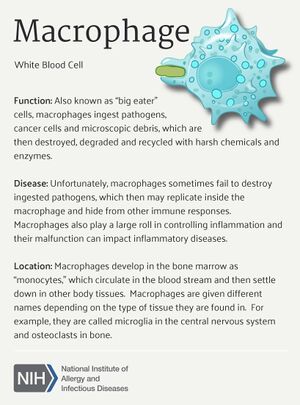Reticuloendothelial System
Original Editor - Lucinda hampton
Top Contributors - Lucinda hampton
Introduction[edit | edit source]
The reticuloendothelial system (RES) is a heterogeneous population of phagocytic cells in systemically fixed tissues that play an important role in the clearance of particles and soluble substances in the circulation and tissues, and forms part of the immune system. Substances that are cleared include immune complexes, bacteria, toxins, and exogenous antigens[1].
The RES: Consists of the phagocytic cells located in reticular connective tissue, primarily monocytes and macrophages. Since phagocytosis is their primary role, mononuclear phagocytic system has been suggested as an alternative name.
Reticular Connective Tissue[edit | edit source]
Definition: A type of connective tissue characterized by the predominance of reticular fibers made of type III collagen and forming a labyrinth-like stroma (framework) for cells such as lymphocytes.
- Connective tissue is one of the major animal tissues. Many connective tissues are comprised of ground substance, cells, and fibers. They are found in between organs or other tissues, connecting them and/or providing support. The ground substance in connective tissues is the amorphous gel-like substance. They are found in between cells, and composed largely of water, glycosaminoglycans, glycoproteins, and proteoglycans. A connective tissue that contains a large network of reticular fibers is called a reticular connective tissue. The reticular fibers are made up mainly of type III collagen (100-150 nm in diameter) synthesized by special fibroblasts, reticular cells. Reticular fibers crosslink, forming a fine meshwork.
- The reticular connective tissues are found in the kidney, the spleen, lymph nodes, and bone marrow. Their function is to form a stroma and provide structural support, such as that in the lymphoid organs, e.g. red bone marrow, spleen, lymphocytes and lymph node stromal cells[2] .
Composition[edit | edit source]
The composition of the reticuloendothelial system includes
- Kupffer cells of the liver
- Microglia of the brain
- Alveolar macrophages
- Bone marrow
- Lymph nodes
- Macrophages in the intestine and other tissues.
Regulation of the Reticular Endothelial System[edit | edit source]
The reticuloendothelial system is also under the leading role of the nervous system and is regulated by chemicals in the body fluids. The state of the cerebral cortex has a great influence on the activity of macrophages in the reticular endothelium.
- The more the cortex is excited, the more activity in the reticuloendothelial system is inhibited. eg when a person's painful cerebral cortex is in an excited state, the function of the reticuloendothelial system is inhibited.
- If the cerebral cortex is in a state of inhibition, such as during sleep or anesthesia, activity on phagocytic cells is enhanced.
- The chemical regulation of endocrine and vitamins also has a certain effect on the function of the reticuloendothelial system. eg. Experiments have shown that in the absence of vitamin C or injection of adrenaline, the phagocytic activity of the reticuloendothelial system becomes sluggish, the phagocytic capacity is also weakened, and the production of collagen fibers is also poor.[1]
References[edit | edit source]
- ↑ 1.0 1.1 CD RES Available from: https://www.creative-diagnostics.com/the-reticuloendothelial-system.htm(accessed 10.6.2021)
- ↑ Biology on line RE connective tissue Available:https://www.biologyonline.com/dictionary/reticular-connective-tissue (accessed 10.6.2021)







